Issue #10 June 9th - June 22nd, 2006
DVD Review:
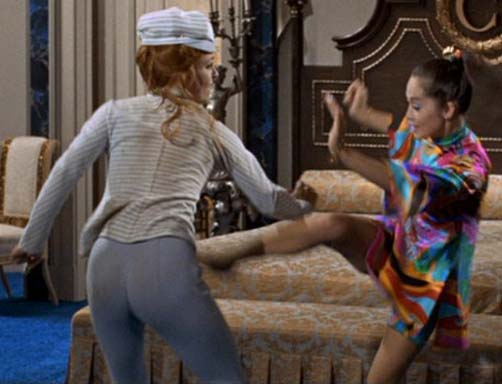 Spy Spoofing in the '60s
Spy Spoofing in the '60s
By: Adrian Fallwell
Thou shalt not put too much money into one picture. And the money you do spend, put it on the screen; don’t waste it on the egos of actors or on nonsense that might appeal to serve highbrow critics. -Samuel Zachary Arkoff (source: imdb.com)
I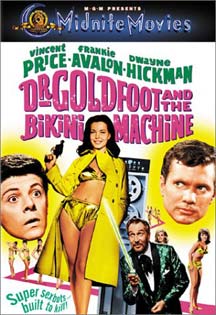 t all started with Samual Z. Arkoff, a pioneer in the exploitation films, starting many genres, including the Beach Party fad and blaxplotation films. Ian Fleming’s 007 Bond character was gaining huge popularity, with Dr. No, Thunderball, and Goldfinger hitting the big bucks in the early ‘60s. In ’65, Arkoff’s American International Pictures produced Dr. Goldfoot and the Bikini Machine, starring Vincent Price as the mad scientist Dr. Goldfoot, and Frankie Avalon as the goofy G-man stumbling upon his evil plot to have a slew of beautiful female robots marry and then financially take over the richest men in the world. Director of nine Elvis movies, Norman Taurog gears the film toward a teenage crowd, enriched with scantly dressed women, at least for the times, and upbeat swingin’ beach party music, with the catchy title song sung by The Supremes.
t all started with Samual Z. Arkoff, a pioneer in the exploitation films, starting many genres, including the Beach Party fad and blaxplotation films. Ian Fleming’s 007 Bond character was gaining huge popularity, with Dr. No, Thunderball, and Goldfinger hitting the big bucks in the early ‘60s. In ’65, Arkoff’s American International Pictures produced Dr. Goldfoot and the Bikini Machine, starring Vincent Price as the mad scientist Dr. Goldfoot, and Frankie Avalon as the goofy G-man stumbling upon his evil plot to have a slew of beautiful female robots marry and then financially take over the richest men in the world. Director of nine Elvis movies, Norman Taurog gears the film toward a teenage crowd, enriched with scantly dressed women, at least for the times, and upbeat swingin’ beach party music, with the catchy title song sung by The Supremes.
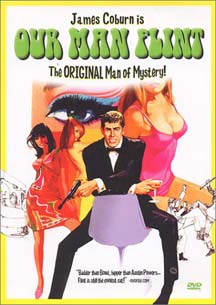 “…and remember, the eyes of Goldfoot are upon you,” croons Mr. Price, referring to the omnipresent video that is displayed on Dr. Goldfoot’s instrument panel. This is a trait that so many movies through the ‘60s and ‘70s had, although seemingly much less common these days with audiences less willing to allow such an unrealistic technology go by. However, with the way things are going, omnipresent video might be making a comeback; probably not in the movies though.
“…and remember, the eyes of Goldfoot are upon you,” croons Mr. Price, referring to the omnipresent video that is displayed on Dr. Goldfoot’s instrument panel. This is a trait that so many movies through the ‘60s and ‘70s had, although seemingly much less common these days with audiences less willing to allow such an unrealistic technology go by. However, with the way things are going, omnipresent video might be making a comeback; probably not in the movies though.
Then the following year spawned two more secret agent characters. One was James Coburn as the over-the-top spy man, Derek Flint, in Our Man Flint. Flint’s a man of men, skilled in not just karate and weapons, but ballet and art as well. Coburn works the action hero well, and shows off a multitude of karate kicks and chops he learned from his real-life master, Bruce Lee. The movie was directed by Daniel Mann, who would go on to direct the odd ‘70s horror-classic, Willard. It also features a young James Brolin playing a small, unaccredited part.
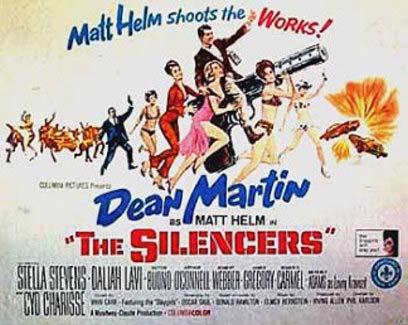 The second character introduced in ’66 was from the novels of Donald Hamilton. Where bikinis will go, Dean Martin will follow, as he takes the Helm in the first of four Matt Helm movies, The Silencers, directed by Phil Karlson. Helm is an ex-agent, who has found a normal life as a photographer in New Mexico, until the sexy Nancy Kovack, Queenie from the “Batman” series, shows up to coax him out of retirement for a special assignment. The Silencers stayed fairly true to the book, although Martin acts more like Dino, then as the books original character. The action movie was a hit, and was actually nominated for a couple of Laurels.
The second character introduced in ’66 was from the novels of Donald Hamilton. Where bikinis will go, Dean Martin will follow, as he takes the Helm in the first of four Matt Helm movies, The Silencers, directed by Phil Karlson. Helm is an ex-agent, who has found a normal life as a photographer in New Mexico, until the sexy Nancy Kovack, Queenie from the “Batman” series, shows up to coax him out of retirement for a special assignment. The Silencers stayed fairly true to the book, although Martin acts more like Dino, then as the books original character. The action movie was a hit, and was actually nominated for a couple of Laurels.
That same year, the second movie was released, Murderer’s Row. This time, directed by Henry Levin, the Helm saga takes a wacky turn, and becomes even more tounge-in-cheek Dino than its predecessor, with Karl Malden playing a bad guy, Ann-Margret doing the sex-kitten thang, and a special musical guest appearance by child-group Dino, Desi, & Billy, the first two being the sons of Dean Martin and Desi Arnez.
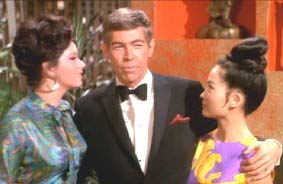 The fad hit full steam in ’67, with a multitude of releases. In Like Flint, the second Flint film, was directed by Hollywood veteran Gordon Douglas, famous for his ’54 horror blockbuster, Them. Coburn actually won a Laurel for this one, and the movie has often been revered as even better than the first. However, while Flint was moving up, Helm took a nosedive.
The fad hit full steam in ’67, with a multitude of releases. In Like Flint, the second Flint film, was directed by Hollywood veteran Gordon Douglas, famous for his ’54 horror blockbuster, Them. Coburn actually won a Laurel for this one, and the movie has often been revered as even better than the first. However, while Flint was moving up, Helm took a nosedive.
 The Ambushers, the third Helm release, is considered the worst of the lot. A government flying saucer is kidnapped, and the electro-magnetic satellite disc that directs the saucer down into the jungle shoots sparks from its center, if that tells you anything about the quality of the script and effects. Of course, one generation’s trash is another generation’s treasure, so the sheer awfulness of this movie makes it more entertaining than the others in some ways.
The Ambushers, the third Helm release, is considered the worst of the lot. A government flying saucer is kidnapped, and the electro-magnetic satellite disc that directs the saucer down into the jungle shoots sparks from its center, if that tells you anything about the quality of the script and effects. Of course, one generation’s trash is another generation’s treasure, so the sheer awfulness of this movie makes it more entertaining than the others in some ways.
Meanwhile, on the other side of Hollywood, the big boys were taking their stab at the spy spoof genre, as well as making fun of the teenage scene, in the grossly expensive, Casino Royale, based off of the first Bond spy novel. The starry cast and cameos include Peter Sellers, Orson Welles, Peter O’ Toole, Woody Allen, Ursula Anderson and John Houston. Even Houston’s daughter, Angelica Houston, makes her unaccredited film debut. The soundtrack was a big hit, with Herb Albert doing the title song and Dusty Springfield doing Bacharach. One of the directors, Ken Hughes, went on to do another Ian Fleming story, executing a complete 180 from the spy genre, with the musical Chitty Chitty Bang Bang.  Trouble between Sellers and Welles plagued the shooting with delays, causing the film to cost more than the Bond movies themselves.
Trouble between Sellers and Welles plagued the shooting with delays, causing the film to cost more than the Bond movies themselves.
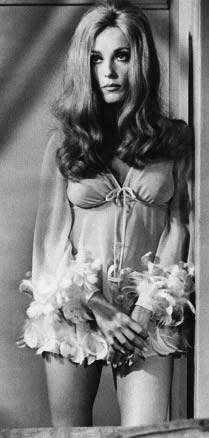 As the late ‘60s became the memorable times that they are now, the off-the-wall and overblown was on its way out for more serious stuff. However, that never stops movie makers from squeezing out every drop they can, so in ’69, we got the final Helm movie, The Wrecking Crew. Dino is over 50, and his head looks like a wine grape about to burst. Karlson is brought back to direct, and Bruce Lee was hired to choreograph the fight scenes, making old Dean a kickin’ fool. There’s also a young Chuck Norris making his film debut, playing a bit part as one of the bad guy guards. However, the most memorable character of the movie is Helm’s bumbling assistant that shows up every time Dean’s about to get him some. The character, Freya Carlson, is played by none other than Sharon Tate; one of the last movies she made before her death. This character is an obvious inspiration to the Felicity Shagwell from Austin Powers.
As the late ‘60s became the memorable times that they are now, the off-the-wall and overblown was on its way out for more serious stuff. However, that never stops movie makers from squeezing out every drop they can, so in ’69, we got the final Helm movie, The Wrecking Crew. Dino is over 50, and his head looks like a wine grape about to burst. Karlson is brought back to direct, and Bruce Lee was hired to choreograph the fight scenes, making old Dean a kickin’ fool. There’s also a young Chuck Norris making his film debut, playing a bit part as one of the bad guy guards. However, the most memorable character of the movie is Helm’s bumbling assistant that shows up every time Dean’s about to get him some. The character, Freya Carlson, is played by none other than Sharon Tate; one of the last movies she made before her death. This character is an obvious inspiration to the Felicity Shagwell from Austin Powers.
Actually, all these movies became the inspiration for the Austin Powers films, with a little more women’s lib compared to the frail and helpless heroines of the ’60s films. The camp, the bikinis, the martinis…it’s just what the summer ordered.
The largest collection of these films, are available at Digital Video Depot on Meridian.
NONzine Reviews Main Page